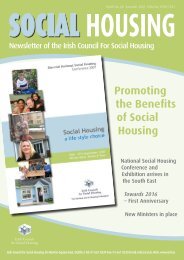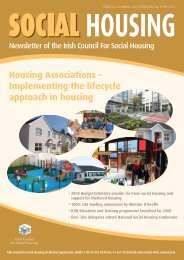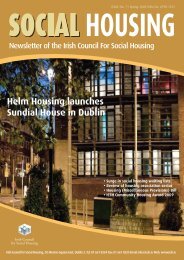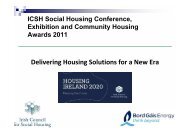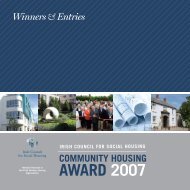National Housing Strategy for People with a Disability 2011 - 2016
National Housing Strategy for People with a Disability 2011 - 2016
National Housing Strategy for People with a Disability 2011 - 2016
You also want an ePaper? Increase the reach of your titles
YUMPU automatically turns print PDFs into web optimized ePapers that Google loves.
9.20 The phased timescales <strong>for</strong> transition will need to be cognisant of the availability ofsuitable housing options and, in this regard, the full range of housing options 79 availableshould be considered in order to meet the arising accommodation need. However, it isrecognised that certain tenures may prove more suitable <strong>for</strong> people <strong>with</strong> mental healthdisabilities. As a supply mechanism, the transfer of existing low and medium support HSEcommunity residences to the management of local authorities or voluntary housing agencieswill be examined. In this context, however, the community residences must be made fit <strong>for</strong>purpose, including through meeting accessibility needs.9.21 In order to support the accommodation needs of people in transition from HSEmental health facilities, a funding stream must be identified. Account will also need to betaken of existing demands on local authority social housing waiting lists and the level offunding which will be available to support the social housing investment programme overthe period of transitions.9.22 Furthermore, it is critical that the provision of appropriate housing options besupported by the provision of tenancy supports, as appropriate, and the provision by theHSE or HSE funded service providers, of health and personal social services in line <strong>with</strong>individual care plans, <strong>with</strong>in the community based setting. The HSE are committed todelivering mental health supports through the multidisciplinary community mental healthteams comprising input from psychiatry, nursing, social work, clinical psychology,occupational therapy and clinicians <strong>with</strong> specific expertise, <strong>with</strong> agreed flexible protocols <strong>for</strong>clinical and operational practice adapted to meet service users’ needs. Currently, there are122 community mental health teams across the country. As wards and hospitals closesequentially, the resources will be reconfigured and further teams will be established. It isimportant to note that, while patients may be discharged from HSE mental health facilities,they will remain as service users and will have access to the full range of mental healthsupports, including home based treatment, day hospital, outpatient facilities and in-patientunits.9.23 Table 9.6 details the geographical spread of people who could potentially requirelocal authority sourced accommodation.79Accommodation options:• Lease / build / purchase by local authorities and approved housing bodies;• Rental Accommodation Scheme (RAS), including RAS type contracts <strong>for</strong> non-rent supplement households;• Private rental sector (including short term income support - rent supplement);• Adaptation grants in respect of private and social dwellings.108108



